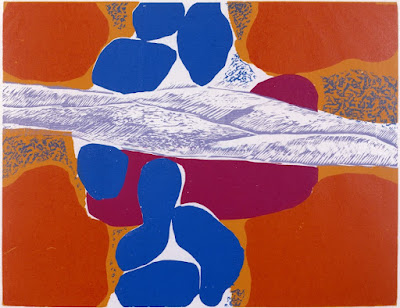 |
Still Life (aka White Jug), c.1950, color lithograph
all works by Robert Blackburn |
The name Bob Blackburn is unlikely to ring a lot of bells with the average art viewer - but a show currently on view at
The Hyde Collection in Glens Falls through April 24, could change that.
 |
| Girl in Red, 1950, color lithograph |
Organized by the Smithsonian Institution Traveling Exhibition Service, and ably curated by Deborah Cullen, Robert Blackburn & Modern American Printmaking, is a show with a story that blends 20th-century American art history with African American history (in other words, highly relevant), while revealing a tremendous talent that was largely overlooked - but not necessarily due to the artist's skin color.
Because Blackburn dedicated himself largely to producing lithographs, etchings, silkscreens, and woodcuts for other artists, his devotion to his own career as an image maker took a back seat. He describes this choice himself in a quote on the gallery wall (one among many that perfectly accompany the works of art in the exhibition), saying "I was torn between building something which I thought had value and doing my own work."
In fact, he succeeded at both, by establishing printmaking workshops that forever changed the way postwar artists used those media, thereby significantly affecting the trajectory of contemporary art, and producing numerous powerful original works in the same media on his own time. Many viewers will be thrilled to see prints here by artists such as Robert Rauschenberg, Charles White, and Grace Hartigan - and those are great! - but I'll focus my comments on Blackburn's work, which makes up about half the show.
 |
| Refugees (aka People in a Boat), 1938, lithograph |
It's immediately clear upon entering the gallery that Blackburn had tremendous ability as an artist. The first image, a lithograph he executed at the age of 17 in 1938, shows an already accomplished skill level, and a mature vision in step with the times. Entitled
Refugees, the piece shows the influence of prominent socially conscious work of the period, such as that by Diego Rivera or Rockwell Kent, but stands on its own as a Depression-era cry of concern.
 |
| Little One, 1960s-1971, lithograph |
Later works move on from figuration into abstraction. Blackburn pointed out his thinking on this process saying, "illustration was one thing and creating vital space is another." Indeed, "vital space" is what he delivers in print after print, whether injecting that into the work of others through collaboration, or in his own masterful pieces.
I had so many favorites around the two large galleries devoted to this collection that I hardly know where to begin. But I will say this: the medium was only a starting point. Blackburn mastered many, and he innovated in them all. So there are prints in almost every technique (including cutting-edge forms) that fulfill Blackburn's creative promise while amply demonstrating his technical contributions.
 |
| Woodscape, 1984, color woodcut |
Among the characteristics that pervade the work, and which help it hold together as a singular body, are Blackburn's brilliant color sense, his compositional daring, and a playfulness that I honestly envy, all of which he maintained over more than 60 years, before illness slowed him down. Undoubtedly, the man worked day and night, and the artists he collaborated with provide quotes in praise of his constant willingness and easygoing personality - it seems they all loved being around the positive energy of Bob Blackburn.
It also seems Blackburn had no quarrel with his relative lack of recognition or fame, further underscoring the sweetness I feel when viewing his personal output. But make no mistake - that work is serious, and important. For each of the pieces I've selected to reproduce here, there are ten more in this wonderful exhibition that are just as good. Try not to miss it.
 |
| Blue Things, c. 1963–1970, color woodcut |










2 comments:
Almost spring? OK; it'll be 60 by next weekend.
Lookin' good. Always new (to me) things to discover.
Post a Comment